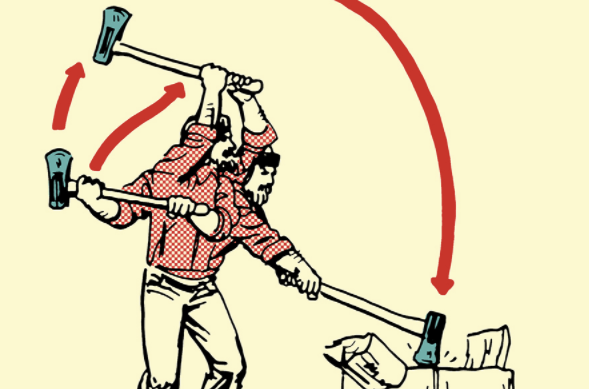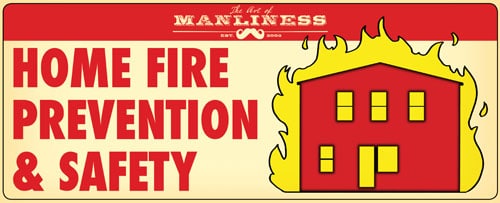
 | This post is brought to you by Kidde Worry-Free Smoke and Carbon Monoxide Alarms. Find out more about the Worry-Free’s 10-year battery life here. What’s this? |
Every year, house fires claim the lives of over 2,500 people and cause around $7 billion in damage. While house fire deaths are dropping (largely due to fire safety awareness), it’s still a number that is far too high for something so often preventable.
When it comes to household fires, heroics don’t start with firefighters, they start at home with you. Keep in mind that when discussing this topic, awareness is not enough. To read the following tips and do nothing is a disservice to your family and home. By taking action with the tips below, you can increase the odds of making sure that a firefighter never has to risk his life running into your burning home, and that if he does, your family will be safe and sound outside.
Fire Safety Equipment
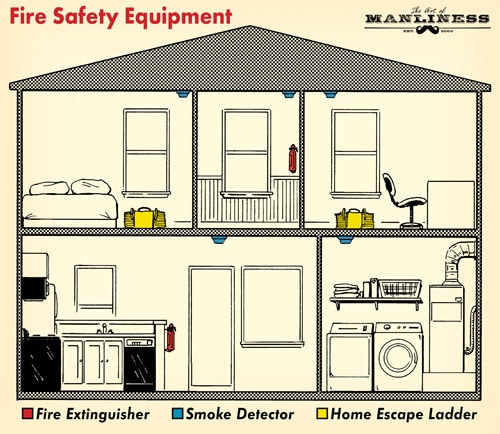
Smoke Detectors
Fire alarms are far and away the number one lifesaver when it comes to fires in the home. In fact, two-thirds of all fire deaths occur in homes with either no working smoke alarm, or no alarm period. In many cases, deaths are the result of an alarm not working properly, most often due to issues with the battery (no battery, dead battery, not connected properly).
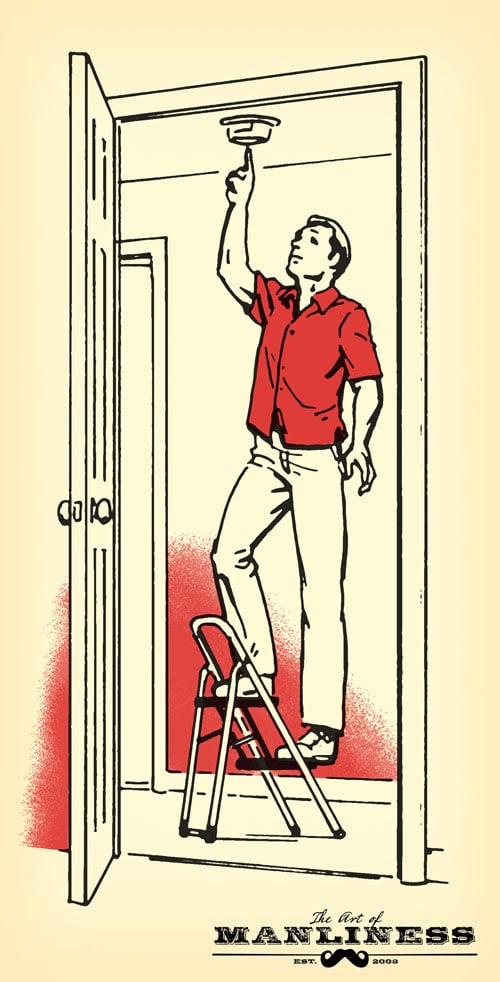
Fire alarms seem like such a small part of your home and get all too easily overlooked, but they’re perhaps the most important pieces of hardware in your abode. Utilizing the following tips will drastically reduce the chances of a deadly fire in your home:
- There are two types of alarms: ionization (better at detecting “flaming” fires) and photoelectric (better at detecting “smoldering” fires). Ionization is the most common, as it’s cheaper and can detect minute amounts of smoke. Your absolute safest bet is to get a dual sensor alarm that utilizes both technologies.
- Make sure alarms are installed in every bedroom, and outside every sleeping area. Also be sure there’s at least one on every floor, including the basement.
- Test your alarms (all of them!) monthly by hitting the “test” button. If the alarm doesn’t work, first replace the battery and try again. If it still doesn’t work, replace the entire alarm.
- Replace the batteries in all your smoke alarms once a year. If an alarm starts chirping with a low battery signal, replace it immediately; don’t just disconnect it in hopes that you’ll remember to do it later.
- Replace the alarm itself every 10 years or when the “test” button fails, whichever comes first. When replacing units, fire officials recommend installing alarms powered by sealed-in, long-life batteries. You’ll never hear the low battery chirp again and never have to worry about your alarms being disabled and unable to sound in an emergency during the 10-year life of the alarm.
- Do not disconnect when cooking. Cooking is the leading cause of home fires, especially around the holidays when ovens and stovetops are used all day long. If the alarm goes off, the tendency can be to just disconnect it for the time being. Instead, turn on your range fan, put a fan near the alarm, open windows, etc.
- Think about every member of your family. If someone in your household is deaf or hard-of-hearing, get an alarm that has a strobe light option. You can also get vibration options if those don’t work. Also be sure that the extra-heavy sleepers will wake up when an alarm goes off.
Escape Ladders
If your home has a basement with window wells, or is any higher than just a single story, you’ll want fire escape ladders on hand.
For window wells, they are generally just a basic metal ladder, 4-5 feet tall, that plants in the ground a few inches, and hooks over the well. Have one for each occupied room of a basement.
Ladders for levels that are higher up come with a little more variety. Use the tips below to ensure you get ones that are right for your family:
- One of the most important features to look for is the presence of “standoffs.” These are small protrusions that hold the ladder rungs away from the house. This provides stability and adequate space for the foot to move down without slipping. The more standoffs, the better.
- There are two standard length ranges: 13-15 feet and 23-25 feet. The shorter models are for second-story rooms, and the longer for third-story rooms. If you have four or five stories, there are ladders available for those as well.
- Make sure it’s been load tested for at least 1,000 pounds, and is clearly marked as such.
- It’s recommended to have one in every occupied room above the main floor. Store them next to potential escape windows, and be sure whoever occupies the room is able to use it properly and efficiently. Have your kids test going down the ladder.
- If you have guest rooms, be sure to have ladders there as well, and inform guests of their presence. This goes for both higher levels and basements.
Fire Extinguishers
Having fire extinguishers in your home and knowing how to use them is a crucial part of your home’s emergency plan. While it can be tempting to use an extinguisher for any fire in your home, you have to be aware of the fact that they should really only be used for fires that are very small and contained — for example in a wastebasket or a small fire in a pot on the stovetop. The number one priority is still the safety of everyone in the home, so if a room begins to quickly fill with smoke, exit the house immediately and don’t try to be the hero.
You should have at least one fire extinguisher on every level of your home. They should be placed in the rooms with the highest probability of a fire — the kitchen especially, and the garage as well. While there are multiple classifications of extinguishers, the variety that are classified as “ABC” will be fine for the majority of homeowners’ needs. We dedicated an entire post last year to using extinguishers, so be sure to read up for more information.
While it’s true that using a fire extinguisher isn’t rocket science there are a few basics you need to be aware of – and probably aren’t. According to FEMA, the majority of Americans don’t know how to use an extinguisher, even if they have one in their home. This is a dangerous knowledge gap. Fires double in size every 60 seconds, so you don’t want to be fumbling around in an emergency situation, reading over the instruction manual as a small flame on the stove grows into an inferno:
- First, determine if the fire is one you can handle with your extinguisher. If it’s taller than you, or the room is filled with smoke, get everyone out of the house.
- Position yourself with your back to an escape, so you can make a quick getaway if necessary. Don’t back yourself into a corner with just an extinguisher in hand.

- Pull the pin.
- Aim the nozzle at the base of the fire. Hitting the tops of the flame with the extinguisher won’t be effective. You’ve got to smother the sucker at its base.
- Squeeze the trigger. In a controlled manner, squeeze the trigger to release the agent.
- Sweep from side to side. Sweep the nozzle from side to side until the fire is put out. Keep aiming at the base while you do so. Most extinguishers will give you about 10-20 seconds of discharge time.
Escape Plan
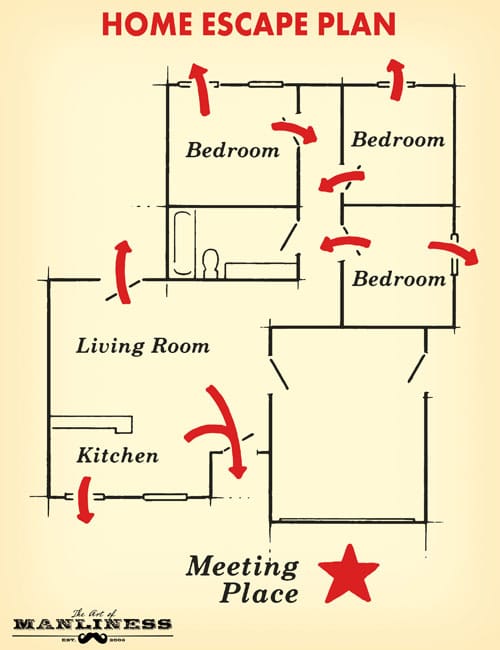
Should a fire break out in your home and the smoke alarm goes off, you need to have a well-rehearsed escape plan. You may have as little as 30 seconds to get out of a burning home, so you can’t waste a single second dawdling around trying to figure out which way to go or where to meet your family. Forty-two percent of homes do not have an escape plan, so if you haven’t done so already, take the time tonight when all your family is together, and create a plan:
- Get everyone is the household together. If you can’t do that, make sure the missing parties are trained on what you went over.
- Walk through every room of your house and draw a plan as you go.
- In your plan, mark where fire extinguishers are and where smoke alarms are.
- Come up with two ways to exit every single room. Through a doorway is always preferred; if that’s not an option, windows offer a plan B. Don’t allow regular occupancy in basement rooms without an egress window; otherwise, there is generally only one escape route.
- Utilize ladders for basement window wells as well as second (or higher) story rooms.
- Teach children how to escape on their own if need be. Have them practice using the escape ladders. Make sure you’re supervising, but this will probably be fun for them to do. Every kid wants a chance to climb out their window.
- Designate a meeting place outside your home; just make sure it’s far enough away that it will be a safe spot.
- Drill your escape plan twice a year, making it as realistic as possible.
- Place your drawn-out plan on the refrigerator as a handy reference. Also point out your plan to any guests you may have that are spending the night at your house. It may seem tedious, but it’s well worth it.
A few other items of note:
- If there are any folks with disabilities in your home, make sure your plan incorporates their needs.
- If there are infants/toddlers, elderly folks, or those with limited mobility in your home, be sure that someone is “assigned” to them to make sure they get out safely in an emergency.
- Close doors on your way out of the home — it slows the spread of fire.
- Ensure that any windows in your escape plan are easily openable. It’s common for windows to get stuck if they don’t get much use, so check the windows every time you drill your escape plan.
- Make sure that children understand the plan, as best as they can for their age. Have them recite it to you, and even have a practice run on their own.
Documentation of Valuables & Fireproof Safes
While certainly not as important as protecting your loved ones, documenting your valuables for insurance purposes can save a lot of headache after the fact. Do you want the added stress of trying to mentally calculate what was lost, or do you want to easily assess a spreadsheet of possessions from each room of your home with the monetary value listed?
A few tips for documenting your valuables:
- A written record is great, but an even more thorough job will include photographic proof, and even sales receipts. So don’t just throw receipts away for your big purchases. Keep them somewhere safe (like a safe — more on that below), or you can even use an app like Evernote to scan and tag receipts.
- Consider taking detailed photos (or even video) of every room in your home to have full photographic proof. Update the documentation every couple years so that it’s up to date with everything valuable you own.
- Ask your insurance agent about having professional appraisals done for particularly valuable items. There’s generally a dollar limit that they’ll cover without an appraisal. In my experience, it’s anything over $2,000-$5,000 that should be appraised and come with a written record.
- Have multiple copies. Relying on just one copy, even in a secure place, is not good enough. Consider having a copy in a bank in a safe deposit box, a copy at a trusted relative’s home, a copy in a safe, and perhaps even an encrypted electronic copy.
You’ll want to then store all this information in a fireproof safe. Be sure to understand what you want to keep in the safe, because not all models will protect electronic devices (that includes USB drives, CDs, DVDs, etc). For storing anything electronic/digital, you’ll need a model whose internal temperature won’t rise above 125 degrees, versus the more common 350 degrees.
In addition to your documentation of valuables, there are some other important documents you should consider housing in your fireproof safe:
- Vital records (birth, marriage, adoption, divorce)
- IDs (passports, copies of driver’s license)
- Social Security cards
- Housing records (mortgage, lease, deed)
- Insurance policies
- Wills, living wills
- Medical records
- Recent tax returns
- Banking information
- Photos/jewelry/small valuables of extra importance to you
Common Fire Hazards
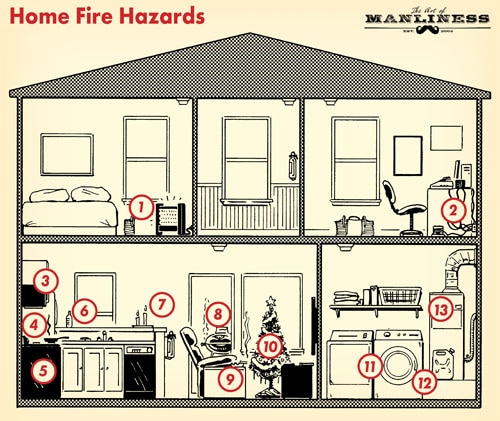
1) Space Heater 2) Congested Outlet 3) Microwave 4) Frying Pan 5) Oven 6) Cooking Oil 7) Candles 8) Barbecue 9) Smoking 10) Christmas Tree 11) Washer & Dryer 12) Gasoline Container 13) Furnace
Over three-quarters of all home fires come from the following common hazards. Knowing what these hazards are and how to best prevent them will go a long way towards protecting your family and your home.
Cooking. Cooking leads to more house fires than any other single source. This includes microwaves, using cooking oil, using fryers, etc. — but by far the greatest factor in kitchen fires is simply unattended cooking.
- Never leave the kitchen unattended while cooking, especially when using oil or high temperatures.
- Be sure that all heating elements are turned off immediately after cooking is done.
- Keep combustible items like dish towels and loose clothing away from cooking surfaces.
- Bear in mind that Thanksgiving and other holidays lead the way in terms of most dangerous single days for cooking, so be extra astute.
Heating equipment. This includes your furnace, fireplaces, radiators, space heaters, etc.
- Have chimneys/fireplaces cleaned and inspected once per year — this is the leading cause of home fires related to heating.
- Have furnace inspected every year, change filters regularly, and consider having air ducts professionally cleaned to prevent the accumulation of dust.
- Never set clothes/shoes on a radiator or space heater to dry.
- Space heaters account for one-third of heating fires. Keep any flammable material at least three feet away, and make sure the heater is on an even and stable surface. Never leave space heaters on overnight or when you leave the home (there are timed space heaters that turn off after 1-4 hours that are a better option). Only use space heaters that shut off automatically when tipped over.
Smoking accidents. The number one cause of home fire deaths. Luckily, this hazard comes with a very simple solution: never smoke indoors (or better yet, never smoke period). When you’re finished smoking, be sure the embers are completely out in the ashtray, and preferably run under water. If you absolutely must smoke indoors:
- Make the bedroom off-limits, this is where the majority of smoking fires start.
- Use a deep ashtray, and make sure it’s always on a stable surface, away from flammable objects.
- Be aware of your drowsiness, especially when drinking. Most smoking fires occur because people drift off and forget to extinguish their cigarette/cigar.
- Never smoke in a home where supplemental oxygen is being used.
Electrical equipment. This includes electric appliances, lighting, outlets, and wiring.
- Check all appliances/lighting for frayed or damaged cords. Unplug and replace immediately if any are found.
- Use tamper resistant (TR) outlets. The average home has 75 outlets, and we all remember as kids how tempting it was to stick things in there. TR outlets utilize small shutters so that only a plug with two/three prongs can be inserted.
- Don’t overload outlets with high-wattage devices. Be especially wary of this in bathrooms and kitchens, and spread out your appliances as best as you can. It’s recommended to only have one high-wattage device per outlet.
- If you have regular problems with an outlet or wiring (sparking, frequent blown fuse, constant flickering in lights), contact an electrician to handle the problem instead of letting it fester.
- In lighting, use light bulbs that match the fixture’s recommended wattage.
- Only utilize extension cords as temporary use devices. If you are using one full-time in your home or garage, install another outlet.
- Don’t run extension cords under rugs, carpet, furniture, etc. Cords can get warm, and if it frays/wears out, it will pose a hazard.
Candles. Are often seen as the number one fire hazard (they aren’t), but with a few small measures, you can nearly eliminate the chance of a home fire happening from a candle.
- As you can imagine, winter is the most dangerous time for candles, with Christmas and New Year’s being the single worst days. Be extra aware, especially on holidays when there’s wrapping paper all over.
- One-third of candle fires start in the bedroom. If you want to have a romantic evening, make sure that candles are on a stable surface and won’t be knocked over. Keep it sexy but safe, folks.
- Keep candles at least a foot away from anything that will easily burn; more than half of candle fires start because they came in contact with a combustible material.
- Blow all candles out when leaving the room.
- Always keep candles out of reach of children.
Accidents involving children. We’ve all been there: kids love fire. Combine that with their insatiable curiosity, and you have a potential disaster on your hands. Heed the following tips to make sure your kids stay safe:
- Keep anything with a possible open flame out of reach of kids. This includes lighters, matches, candles, etc.
- Most of the fires in this category are caused by kids under 10 who play with matches and lighters. Even if you take the above advice, it seems like kids can still find ways to get their hands on fire. Most often, they know it’s bad, so will play in their rooms or closets. Be sure to: regularly check on your kids (especially if doors are closed and they are being extra quiet), know how many lighters/match boxes are in the home and where they are, bring up any melted toys you may find or burned spots on clothing.
- The best thing you can do is to simply teach your children about fire and fire safety. Teach them the escape plan, the sound of the smoke alarm, and even how to use fire as a tool. When they get old enough, let them help with the fire pit in your backyard, or with burning the brush in the fall (if legal in your area, of course). Taking the mystery out of fire is a good way to decrease their curiosity about it.
Flammable liquids. This would include gasoline, cleaning agents, paints, adhesives, etc. Vapors can ignite from high temperatures, or small sparks from static electricity or other sources. Don’t store these flammables near a heating source, but preferably outside the home in a cool, ventilated area.
Christmas trees/decorations. Decorating for the holidays accounts for hundreds of house fires each year. It’s easy to think of just how nice everything looks without realizing its potential hazard.
- Christmas trees are far and away the worst offender here. The real ones need a lot of watering, so keep it in a stand that can hold 2-3 liters, and top it each day. A dry tree with lights that can get hot when left on for too long can be a deadly combination.
- Keep the tree away from any heat sources, including radiators, fireplaces, space heaters, etc.
- Keep lit candles at least 12 inches away from your Christmas tree.
- If using a fake tree, make sure it’s flame retardant.
- Ensure that your decorations don’t interfere with your fire escape plan. Do not block windows or doorways if possible.
- Don’t leave holiday lights on unattended — both on the tree and outside. This is a toughie, as we all like to come home to a lit house, so if nothing else, don’t leave them on for more than a few hours if you’re away. Definitely don’t leave them on overnight or while you’re away for multiple days.
- Check your holiday lights before putting them on the tree or the house. Be sure there are no frays or broken bulbs that could have an exposed element.
- Don’t overload your outlets. As much as your inner man wants to light up the whole world like Clark Griswold, don’t do it. He’s lucky his power outage didn’t turn into a more serious problem.
Grilling. ESPN anchor Hannah Storm’s accident last year brought grilling safety to the forefront of people’s minds. If done properly, grilling is perfectly safe, but without thought or care it can turn dangerous very quickly.
- Always, always grill outside. Garages don’t count as outside. It should be placed well away from the home, as well as from decks and low-hanging tree branches.
- Clean the removable parts of your grill regularly, and don’t let grease build up on the trays underneath propane grills.
- Never leave the grill unattended.
- Check for propane leaks at least once per year. To do this, apply a light soap and water solution to the gas tank hose. A propane leak will release bubbles. If there is a leak, immediately turn off the gas.
- Do not smoke while grilling.
- When done cooking, ensure that the burner controls are turned off and that the propane cylinder valve in closed.
- If you have a cover, make sure the grill is off and cooled before covering.
Clothes dryers. Seeing as how lint is a fantastic firestarter, it makes sense that an ill-maintained dryer could pose a serious threat.
- While it’s not common these days, don’t use a dryer that doesn’t have a lint filter.
- Clean the lint filter after every load. Also clean any lint from around the drum, and around the housing for the lint filter.
- At least once per year check the air exhaust pipe to the exterior of the home. Ensure that there is no blockage. While the dryer is running, you should feel (and smell) the fresh laundry air coming out.
- Preferably, don’t leave the dyer on overnight or while you’re not home.
- Don’t overload the dryer, as it can lead to an excess of lint.
Many of these tips are common sense, and yet when we have other things on our mind (especially at dinnertime, around the holidays, etc.), we can lose track of those basic precautions we’re normally on top of. You can never play it too safe with fire prevention. The most valuable things in the world — our home and families — depend on it.






